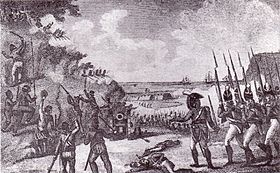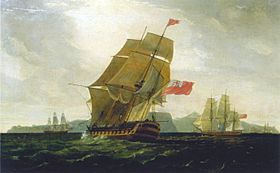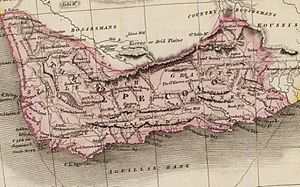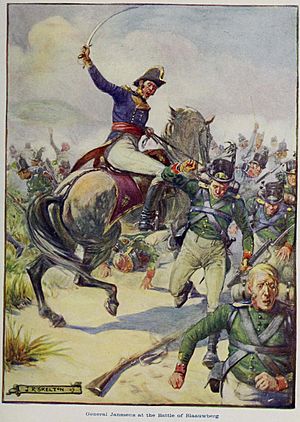Battle of Blaauwberg facts for kids
Quick facts for kids Battle of Blaauwberg |
|||||||
|---|---|---|---|---|---|---|---|
| Part of the Napoleonic Wars | |||||||
|
Clockwise from top: The Storming of the Cape of Good Hope, HMS Diadem at the capture of the Cape of Good Hope, by Thomas Whitcombe, A panoramic painting of the battle.
|
|||||||
|
|||||||
| Belligerents | |||||||
| Commanders and leaders | |||||||
| Strength | |||||||
| 5,399 | 2,049 | ||||||
| Casualties and losses | |||||||
| 189 wounded, 15 killed. 36 drowned before the battle. |
337 "did not answer the roll call" after the battle. Over 700 killed & wounded (letter from British commander Baird). | ||||||
The Battle of Blaauwberg, also known as the Battle of Cape Town, was an important fight during the Napoleonic Wars. It happened near Cape Town on 8 January 1806. After the British won, a peace agreement was signed under the Treaty Tree in Woodstock. This battle led to British control over the Dutch Cape Colony. This change had a big impact on the region for many years. A special event was held in January 2006 to remember the battle's 200th anniversary.
Contents
Why the Battle Happened
At that time, the Cape Colony was controlled by the Batavian Republic. This republic was closely linked to France. The sea route around the Cape was very important for the British. They wanted to take control of the colony. This would stop France from using the sea route. So, a British fleet was sent to the Cape in July 1805. They wanted to get there before French ships could bring more soldiers to the Cape.
The colony was led by Lieutenant General Jan Willem Janssens. He was also the commander of its military forces. His forces were small and not very well trained. They included soldiers from other countries hired by the Batavian government. Janssens gathered what troops he could. These included:
- Soldiers from Waldeck.
- Two Batavian battalions.
- A group of Batavian light dragoons (horse soldiers).
- Batavian horse artillery.
- Over 200 sailors and marines from two French warships.
- Local troops like 181 Hottentots.
- 224 Burghers (citizens) from Swellendam who were also dragoons.
- 54 Javanese artillerists with 104 Mozambican slaves helping them.
The Campaign Begins
The British force left England in August 1805. It was led by David Baird. The group included nine warships and many transport ships. Commodore Home Riggs Popham was in charge of the ships. His flagship was the 64-gun HMS Diadem.
The first British warship arrived at the Cape on Christmas Eve 1805. It attacked two supply ships near the Cape Peninsula. Baird had been told that the colony would not have many soldiers defending it. He was also told that the local people might welcome the British. Janssens knew the British were coming. He put his soldiers on high alert. When the main British fleet arrived in Table Bay on 4 January 1806, Janssens prepared for battle. He declared martial law, meaning the military took control.
British Landing
Rough seas caused a delay. But on 6 and 7 January, British soldiers landed at Melkbosstrand. This area is north of Cape Town. Commodore Popham sank a small ship to create a safe landing spot. During the landing, 36 men from the 93rd Highland regiment drowned. Some local dragoons tried to stop the landing. Janssens did not want to fight on the beach. He feared the British ships would fire on his troops.
Janssens moved his forces to meet the British. He believed winning was impossible. But he felt it was important to fight for his homeland's honour. He planned to attack the British on the beach. Then he would retreat inland. He hoped to wait there until French ships arrived with more soldiers.
However, on the morning of 8 January, Janssens's troops were still moving slowly. Baird's British soldiers had already marched towards Cape Town. They reached the slopes of the Blaauwberg mountain (now called "Blouberg"). This was a few kilometres ahead of Janssens's forces. Janssens stopped and formed a battle line across the open field.
The Battle
The battle started at sunrise with cannons firing. Then Janssens's cavalry (horse soldiers) attacked. Both sides fired their muskets. A group of hired soldiers from Waldeck were in the middle of Janssens's line. They ran away when the British 71st regiment got close. This left the Batavian centre exposed. The two regiments next to them also began to fall apart. Janssens tried to rally some of his troops.
About 200 French sailors and marines fought very bravely. They kept fighting even though their sides were exposed. Ten cannons in the centre were fired by 54 Javanese artillerists and 104 Mozambican slaves. The 71st Highlanders charged forward and captured these cannons. They fought hard against the Javanese artillerists. As Janssens's centre collapsed, he ordered his troops to retreat. His regular soldiers retreated quickly. But his local militia and helpers fought as they pulled back. They were eventually forced to flee.
Janssens started the battle with 2,049 soldiers. He lost about 337 or 353 men killed or missing. Baird's British forces had 5,399 men. They suffered 204 casualties, with 189 wounded and 15 killed.
British Take Control
After the battle, Janssens moved inland to a farm. From there, his troops went to the Elands Kloof in the Hottentots Holland Mountains. This was about 50 kilometres from Cape Town.
The British forces reached the edge of Cape Town on 9 January. To protect the town and its people, the commander of Cape Town, Lieutenant-Colonel Hieronymus Casimir von Prophalow, surrendered. He gave the outer forts to Baird. They then discussed the terms of surrender.
The official surrender papers for the town and the Cape Peninsula were signed the next day. This was on 10 January, at a small house in Papendorp. This place is now the suburb of Woodstock. The house became known as "Treaty Cottage." The house is gone now, but Treaty Street still remembers the event. The tree under which they signed the agreement is still there today.
After the Battle
Janssens and his remaining troops had not yet surrendered. He was still hoping that the French ships he had been waiting for would arrive. He had only 1,238 men left. About 211 more soldiers left him in the following days.
Janssens stayed in the mountains for another week. Baird sent Brigadier General William Beresford to talk with him. The two generals met at a farm on 16 January. They did not reach an agreement at first. Janssens finally agreed to surrender. The final surrender papers were signed on 18 January.
It is not fully clear where these final papers were signed. For many years, people thought it was at the Goedeverwachting estate. But newer research suggests it might have been at Croeser's farm. This farm is now the Somerset West golf course.
The terms of surrender were fair to the Batavian soldiers and people of the Cape. Janssens and his Batavian officials and troops were sent back to the Netherlands in March.
The British officially took over the Cape on 13 August 1814. The Netherlands gave the colony to Britain permanently. The Cape remained a British colony until 31 May 1910. On that date, it became part of the Union of South Africa.
What the Surrender Meant
The surrender agreements set out the rules for the British takeover. Here are some key points:
For Cape Town (10 January 1806)
- Cape Town and its forts were given to Great Britain.
- Soldiers became prisoners of war. But officers who lived in the colony could stay free if they behaved.
- Officers sent back to Europe would be paid and transported by the British.
- All French people in the colony had to return to Europe.
- Citizens who had fought could go back to their jobs.
- All private property would be safe.
- Public property would be listed and handed over.
- Citizens would keep their rights, including freedom to worship.
- The money in use would stay valid.
- The Batavian government's property would guarantee the money.
- Prisoners of war would not be forced to join the British army.
- British soldiers would not stay in citizens' homes.
- Two ships sunk in Table Bay had to be raised and given to the British.
For the Rest of the Colony (18 January 1806)
- The whole colony was given to Great Britain.
- Batavian troops would go to Simon's Town with their weapons and belongings. Officers could keep their swords and horses.
- Batavian troops would not be considered prisoners.
- Janssens's Hottentot troops would also go to Simon's Town. They could then go home or join the British.
- The British would pay for the Batavian troops until they left.
- Batavian troops would be sent to a port in the Batavian Republic.
- Sick soldiers would stay behind and be sent home when they recovered.
- The rights given to Cape Town citizens would also apply to the rest of the colony. But British troops could stay in homes in country areas.
- Once on ships, Batavian troops would be treated like British troops.
- Janssens could send a message to Holland, and the British would help.
- Any problems with the surrender terms would be decided fairly.
See also
- Military history of South Africa
- Bloubergstrand, Cape Town
Sources
- Lt Gen Janssens's Report (Cape Archives: ref VC80)






